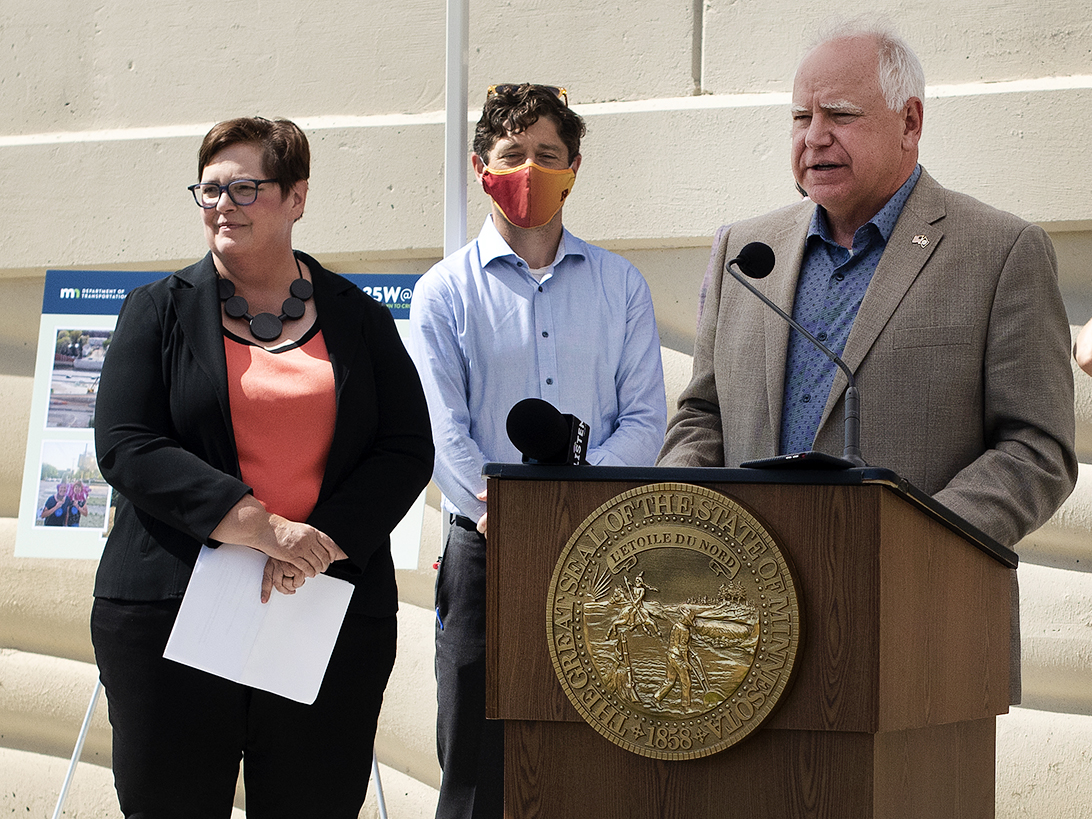
A view of the 35W@94 project, looking north at the new Franklin Avenue bridge. The four-year, $239 million project officially opened Friday, Sept. 10. Photo by Rich Kemp |
By Joseph Palmersheim
Like many commuters coming from the west side of the Twin Cities, Aaron Tag was able to get an up-close look at work on the 35W@94 project in Minneapolis every time he drove to work.
He knew more than most drivers about the local landmark – 35W@94 was the biggest project the Metro District West Area engineer had ever worked on at the agency.
And now, he gets to see completion.
After nearly four years of construction, MnDOT’s 35W@94 Downtown to Crosstown project opened Friday, Sept. 10, finishing on-time and on-budget. The five-stage, $239 million project was the first major update to the interchange area (built in 1967) since dynamic price lanes were added in 2009.

Commissioner Margaret Anderson Kelliher and Minneapolis Mayor Jacob Frey look on as Gov. Tim Walz speaks during a media event marking the opening on the 35W@94 project Friday, Sept. 10. Photo by Rich Kemp |
“To the residents of Minneapolis, the local businesses, and all Minnesotans who travel on Interstate 35W and I-94, we want to say thank you for patience,” Commissioner Margaret Anderson Kelliher said during a Sept. 10 news conference. “This work will benefit everyone who lives, walks, bikes, uses transit or drives in the area.”
Crews rebuilt 2.5 miles of freeway between 43rd Street and I-94; rebuilt and repaired bridges; added access from southbound I-35W to a rebuilt Lake Street, providing a connection to businesses; and added a ramp from northbound I-35W to 28th Street.
They also rebuilt the ramp from I-35W north to I-94 west, including a dedicated lane for motorists seeking to continue through the Lowry Tunnel.
Metro Transit built a transit station at 31st and Lake streets. The station is the centerpiece of the Orange Line bus service (launching later this year) to provide faster bus service into downtown Minneapolis.
A southbound E-ZPass lane was added for vehicles with at least two occupants, motorcyclists and single-occupancy vehicles willing to pay during peak hours.
Walkers and bikers have improved paths and bridges, including new 24th and 40th street bridges that are wider and more accessible. The Green Crescent provides walking and biking access from Midtown Greenway and Lake Street with green space.
Finally, crews replaced aging bridges at 26th Street, 38th Street and Franklin Avenue.
“It’s one of the biggest projects that we’ve had,” Tag said. “It’s a two-mile segment of I-35W in the heart of the urban core of Minneapolis. You don’t have any room to work on the sides. Completely reconstructing freeway in this area, along with 11 bridges, is a complex undertaking.”
And MnDOT didn’t do the work alone.
“Metro Transit is a big piece of this, with the big transit station on Lake Street,” Tag said. “Hennepin County had us rebuilding a number of blocks of Lake Street. The city of Minneapolis had work they added as well. Adding three partners to the project adds complexity, but that is one of the things that make it successful.”
A project this size is challenging on its own, but throw in the events of 2020 on top of it and you get something else entirely. The pandemic turned out to be a mixed blessing, because it reduced daily traffic volumes for a while and allowed the contractor to do things like lane closures during the day. Normally, that wouldn’t be possible in the area, Tag noted.
And another thing that doesn’t seem possible? That this project, decades in the making, could actually be finished.
“I started the job I am in now in March 2017, and this project started later that year, so it’s been most of my time in this job,” Tag said. “I’ll look back at this one as a project that really was quite successful.”
| 


